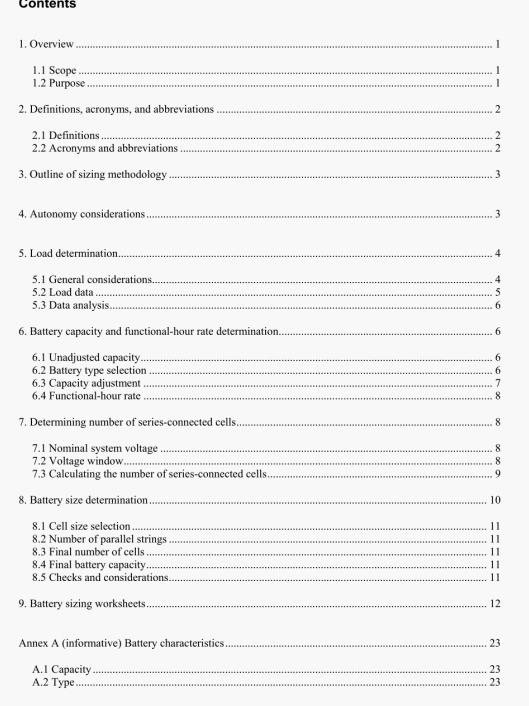IEEE 1013:2007 pdf free download.IEEE Recommended Practice for Sizing Lead-Acid Batteries for Stand-Alone Photovoltaic (PV)Systems.
6.3 Capacity adjustment
After initial battery selection and sizing, the final battery’s capacity is determined by making adjustments for various battery, operational, and PV system factors.
6.3.1 Discharge adjustments
The unadjusted capacity should be modified to assure satisfactory battery cycle life. Battery manufacturers rate lead-acid cells for maximum depth of discharge (MDOD). maximum daily depth of discharge (MDDOD). and end-of-life (FOE) capacity. The battery capacity should be adjusted in the following ways:
a) The capacity adjusted for M[)OD is obtained by dividing the unadjusted capacity by MDOD (in percent).
b) The capacity adjusted for MDDOD is obtained by dividing the maximum daily ampere hours by MI)DOD (in percent).
c) The capacity adjusted for life is obtained by dividing the unadjusted capacity by the F.OL capacity expressed in percent of the rated capacity. While 9C/ is often used as the WI capacity in float-service applications, this value may mean earlier replacement than necessary for PV applications. This is due to a number of factors including the incomplete charging that can occur in PV applications. The resulting apparent loss in capacity results in a reduction of the auwnomy period. If a fixed period is necessary, a larger IEOL battery capacity should be used. Using an EOL percentage less than 80% in sizing the battery is one method of achieving this additional capacity.
d) The largest of these three capacities satisfies the MDOD. MDIX)I), and EOL adjusmients.
6.3.2 Temperature adjustment
The available capacity of a battery is affected by its operating temperature. Cell capacity ratings are generally standardized at 25 °C in the United States. Other countries may use other temperatures when rating their battery capacities. The battery’s capacity increases for temperatures above and decreases for temperatures below that used for the battery’s capacity rating. When sizing a battery. its capacity is rarely adjusted for warm-temperature operation. but adjustments should be made for cold-temperature applications. Refer to the battery manufacturer’s literature for temperature correction factors. The discharge-adjusted capacity detennined in 6.3.1 should he further adjusted by this factor to yield a temperature-adjusted capacity.
6.3.3 Design margin adjustment
It is prudent design practice to provide a capacity margin to allow for uncertainties in the load determination, e.g., less-than-optimum load-operating conditions and load growth. A common practice to provide this design margin is to add 10% (025% to the capacity as determined in 6.3.2.
IEEE 1013:2007 pdf free download
